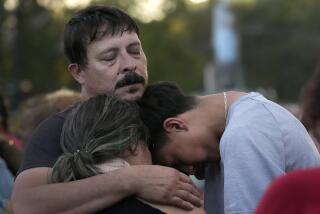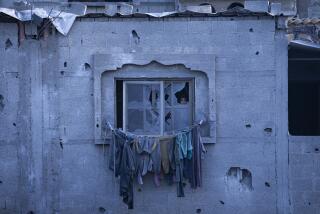Trade Center Site Becomes Evolving World of Its Own
- Share via
NEW YORK — They call it the Hard Hat Cafe--a ramshackle, leaking tent pitched in front of a closed office building over what once was a subway grate.
There are two park benches out front, and ashtrays sit on tables adorned with Popsicle stick and foil decorations made by South Carolina schoolchildren.
Inside there are cozy Christmas lights above the decontamination sink, giant bottles of Advil and nasal spray, and trays of junk food.
Officially it is a Salvation Army mission at ground zero, but it looks more like a scene from “MASH.”
If the World Trade Center housed a small city’s worth of 50,000 people, ground zero has replaced it as a world all its own. Where men and women toting briefcases once arrived daily from the suburbs, now dump trucks rumble in and out ceaselessly from Jersey City and Brooklyn.
Where the sleek towers once soared a quarter-mile into the sky, excavators and rescue workers are digging several stories underground, in mangled basement catacombs.
And as 853,082 tons of rubble has been cleared, other structures have sprung up.
There is the “Taj Mahal,” a giant white tent where the Salvation Army serves up to 6,000 meals a day.
There is the “T-Mort,” the temporary morgue tucked on the sidewalk next to a shuttered Brooks Brothers clothing store.
And there is “1010,”the tiny firehouse where all who were on duty that morning perished. It has become a sort of front porch for visiting firefighters and celebrities.
More than three months after the attacks, work goes on seven days a week, around the clock, on the 17-acre site, which could fit 12 football fields with room to spare. Much has been accomplished. The immense pile of rubble across which frantic bucket brigades scrambled in the first days is gone, replaced by a vast, irregularly shaped open pit.
The underground fires are mostly out. Workers are now focused on shoring up the massive foundation that holds back the Hudson River, and digging through the bottoms of the elevator shafts, concourses and lobbies to where so many people fled. Two weeks ago, they pulled out nearly 40 sets of human remains in just three days. The official death count stands at 2,954, with 444 missing, and 563 bodies and more than 10,000 partial remains recovered.
There are roughly two 12-hour shifts here. Most of the 1,000 construction and rescue workers laboring in the ruins work at least six-day shifts. They spent Thanksgiving at the site, and they’ll spend Christmas here as well.
The sight of a plane flying overhead is jarring. The rain falls occasionally, the sun rises and sets, but days are also measured by the floodlights that come on at dusk and are switched off at dawn.
There are none of the catcalls or obscenities of a normal New York work site. Workers often speak of being numb.
“You get immune--the body bags are like bags of leaves to me now,” said Tom Gorham, 29, a fourth-generation ironworker from Queens. In the early days of the bucket brigades, he often found himself moved to the front of the line so he could cut a body free.
“The first time I didn’t want to look, I just focused on the steel, and I made myself do it,” he said.
Ironworkers Called the Unsung Heroes
The scariest part for him was having to go straight up the facade of Tower One in the cherry picker to cut the structure down, held in by a harness as the little basket swung wildly in the wind. It was eerily quiet up there, as all the noise of the site fell away, he said.
On Dec. 15, the final piece of the facade came crashing down.
The ironworkers are the unsung heroes here, according to everyone else at the site. They dropped what they were doing across the city and ran there with their tools on Sept. 11.
They have been joined by electricians, carpenters, machine operators, surveyors, pipe layers and scores of workers from other trades, as well as firefighters and police.
All are watched over by the Federal Emergency Management Agency and the Occupational Safety and Health Administration, and by the city Office of Emergency Management and Department of Design and Construction, among others.
Tensions mount occasionally, most notably in early November, when city officials tried to cut back on the number of fire department spotters. After bitter rescue workers clashed with police in front of nearby St. Paul’s Chapel, the idea was scrapped.
Plans have also quietly been shelved to bring in a private site manager, Bechtel Construction Corp., a multinational giant based in San Francisco that contributes heavily to the Republican Party.
“There would’ve been a riot if they brought them in,” one worker said flatly.
As it is, four local construction companies, area heavyweights, are working under emergency contracts that will be capped at a total of $1 billion. Work is expected to last up to eight more months.
Many people at the site have close ties to it--older tradesmen who helped build the towers, firefighters who lost partners and relatives, or workers whose siblings or spouses escaped that morning.
“We were just young pups then. It was a thrill to be working on it,” said Frank Nicholas, an ironworker whose first job three decades ago was working on the World Trade Center. “Now it’s just a huge empty space. It’s a personal loss. It’s like the kids going off to college.”
Firefighter Tony Marden is looking for his cousin Tom Casovia. He was supposed to be in his wedding on Oct. 13; instead he now regularly briefs Casovia’s mother and fiancee about recovery efforts.
“My cousin is in the north tower,” he said matter-of-factly, piercing blue eyes staring out from under a weather-beaten helmet. “He’s talking to me; he’s helping me find him.”
Johnny Wiley, a Long Island mortgage broker who took a leave from his job to work as a laborer here after his brother escaped from one of the towers, says he senses the thousands of souls who died at the site every morning when he arrives.
“Their spirits feel it, they know we’re looking for them,” he said. “The first thing I do when I get out here is pray.”
Grim Determination Keeps Workers Going
He and others also notice the family members who visit and silently watch them work.
“It’s sad. I saw one family the other day with what looked like a little 12-year-old girl. I just wanted to go over and hug her,” he said.
There are flashes of unexpected beauty--rainbows in the water arcing from hoses and vivid sunsets in the freakishly open sky. But mostly it is just backbreaking, mind-numbing work. Tired eyes, tired muscles, sore throats and a grim determination to keep looking.
Rituals have developed over the last four months.
Catholic Mass is held Sunday mornings under a twisted crossbar, behind what was Tower One.
A flourishing underground economy has evolved: A microwave is procured for the cafe after its owner accepts three packs of cigarettes; women who use a flush toilet in the lobby of a nearby hotel usually bring along a “gift” of potato chips or soda for the guard.
To get around, workers use “gators,” dozens of green four-wheelers donated by John Deere that shimmy through the muck of the perimeter streets or up and down the dirt ramps of the pit.
And often they stop by the Hard Hat Cafe. “Hey Frankie, do you need a dry T-shirt?” Denise Casalinuovo sings out. She and her husband, John, have been running the Salvation Army mission since Sept. 11.
She orders Chap Stick, T-shirts and socks on her cell phone from various disaster relief warehouses, calling out greetings and wrapping workers in bear hugs all the while.
“We sprang up from the rubble, like everything else,” John says. “A little bit of civilization goes a long way in a war zone.”
“These people are here for you,” says Frankie Burke, a machine operator who is suddenly overwhelmed as he tries to talk. He takes off his respirator and cries soundlessly for a few seconds, then wipes his eyes and prepares to leave.
Outside in the southeast end of the pit, the jaws of a bright orange excavator delicately loosens tangled steel and rubble. Two weary firefighters with vests marked “spotter” stand underneath, searching intently as it scoops up and drops each load twice, like a lion playing with a mouse.
When they see nothing, the debris is loaded into a dump truck and taken to a waiting garbage scow for the trip across New York Harbor to the Fresh Kills Landfill, where it is sifted one more time.
But if the spotters notice any sign of remains, work stops at once. Often a body is trapped, and the ironworkers are called in.
Toting long metal lances called “firecutters” or “torches,” they crawl over the rubble or perch on it.
At one point, they delicately cut away a 45,000-pound piece of steel pinning down an arm. Firefighters tenderly remove the remains by hand and place them in a red plastic bag, even as their eyes and nostrils burn. Very rarely, they need a full black body bag. The workers form a double line, snaking from inside the hole to street level. Attention is called as a flag is draped over the remains. A chaplain recites muffled prayers through a respirator.
Msgr. Edward Mitty, 77, a Catholic priest for 52 years, says he has a favorite prayer he uses.
“Saints of God, come to meet him. Angels of the Lord, receive his soul, and present him to the God most high,” he recites softly from a well-thumbed funeral pamphlet, gazing up at the vacant buildings ringing the site.
“And may the angels lead you into paradise, and may the martyrs come to welcome you, and take you to the holy city.”
The hats go back on, the machines start up and work begins again.
More to Read
Sign up for Essential California
The most important California stories and recommendations in your inbox every morning.
You may occasionally receive promotional content from the Los Angeles Times.












